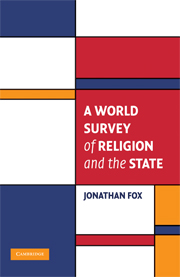Book contents
- Frontmatter
- Contents
- Acknowledgments
- 1 Introduction
- 2 The Question of Religion's Role in Politics and Society Modernization, Secularization, and Beyond?
- 3 Quantifying Religion
- 4 Global GIR from 1990 to 2002
- 5 Western Democracies
- 6 The Former Soviet Bloc
- 7 Asia
- 8 The Middle East and North Africa
- 9 Sub-Saharan Africa
- 10 Latin America
- 11 Patterns and Trends
- 12 Conclusions
- Appendix: Data Collection and Reliability
- Bibliography
- Index
10 - Latin America
Published online by Cambridge University Press: 05 June 2012
- Frontmatter
- Contents
- Acknowledgments
- 1 Introduction
- 2 The Question of Religion's Role in Politics and Society Modernization, Secularization, and Beyond?
- 3 Quantifying Religion
- 4 Global GIR from 1990 to 2002
- 5 Western Democracies
- 6 The Former Soviet Bloc
- 7 Asia
- 8 The Middle East and North Africa
- 9 Sub-Saharan Africa
- 10 Latin America
- 11 Patterns and Trends
- 12 Conclusions
- Appendix: Data Collection and Reliability
- Bibliography
- Index
Summary
Latin America is relatively religiously homogeneous. The majority population in most states is Catholic, and most non-Catholics are Christian. The information presented in Tables 10.1, 10.2, 10.3, and 10.4, shows that nearly all Catholic states give preferential treatment to the Catholic Church. Four states, all Catholic states, have official religions, and an additional 12, also all Catholic, are coded as civil religion – which is defined by the RAS project as a case where one religion is clearly given preferential treatment compared to others, but this religion is not declared the official religion. Among the Catholic majority states, only Brazil, Ecuador, Mexico, and Uruguay do not give the Catholic Church preferential treatment. The pattern of non-Catholic majority states is nearly the opposite. Only Jamaica, among the 7 such states, gives preferential treatment to both Protestant and Catholic churches. Suriname supports all religions more or less equally. The other 5 are either neutral or hostile to religion.
Other than those having to do with conversion, all of the types of restrictions on minorities coded by the RAS project are present in Latin America, but none are common enough to be present in a majority of Latin American states. The most common forms of restrictions are registration requirements and limits on proselytizing, mostly through restrictions on visas for foreign religious workers. Thus, overall, Latin America is comparatively tolerant of its religious minorities.
Other than in Cuba and Guyana, there is very little regulation of the majority religion by Latin American states.
- Type
- Chapter
- Information
- A World Survey of Religion and the State , pp. 290 - 312Publisher: Cambridge University PressPrint publication year: 2008

